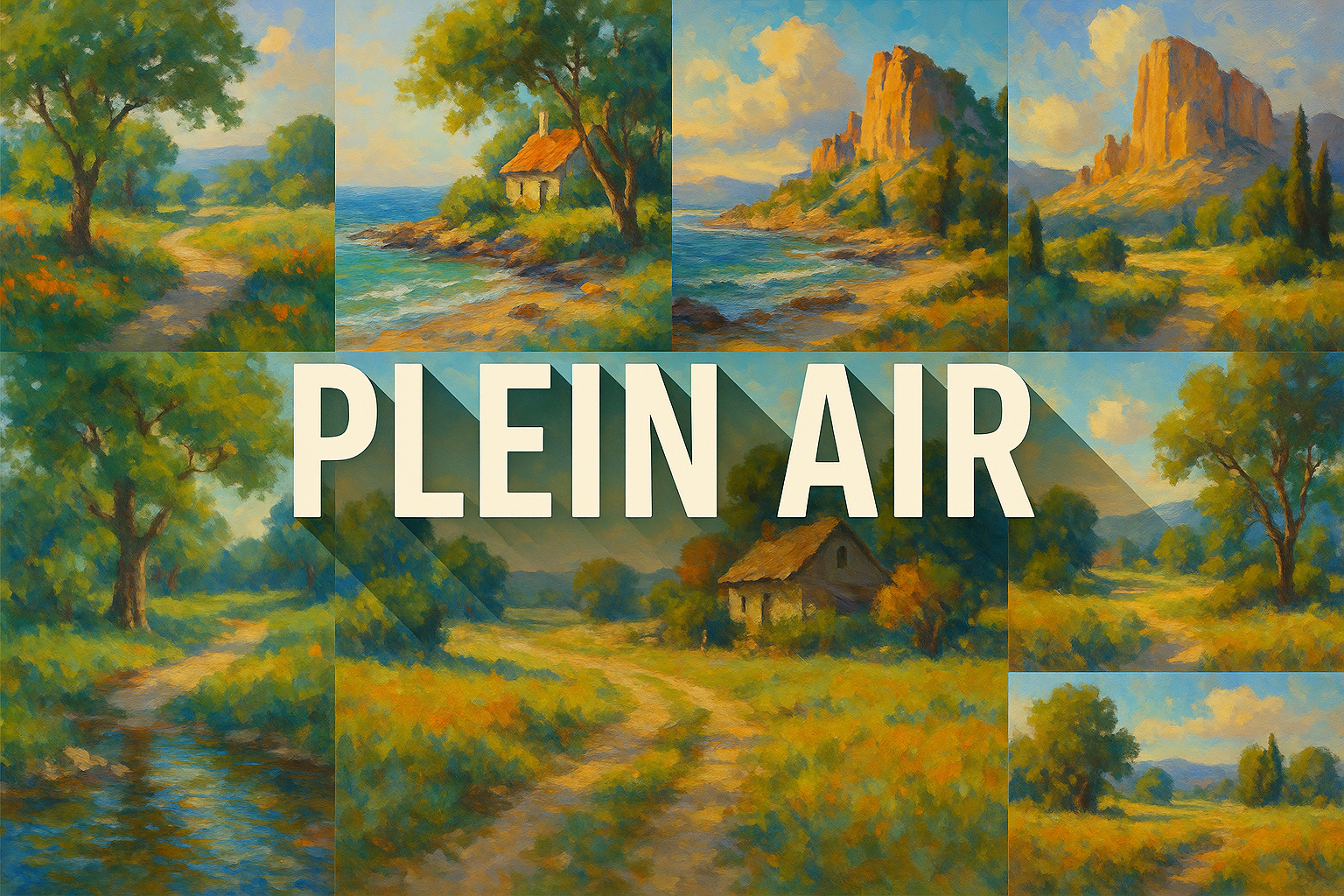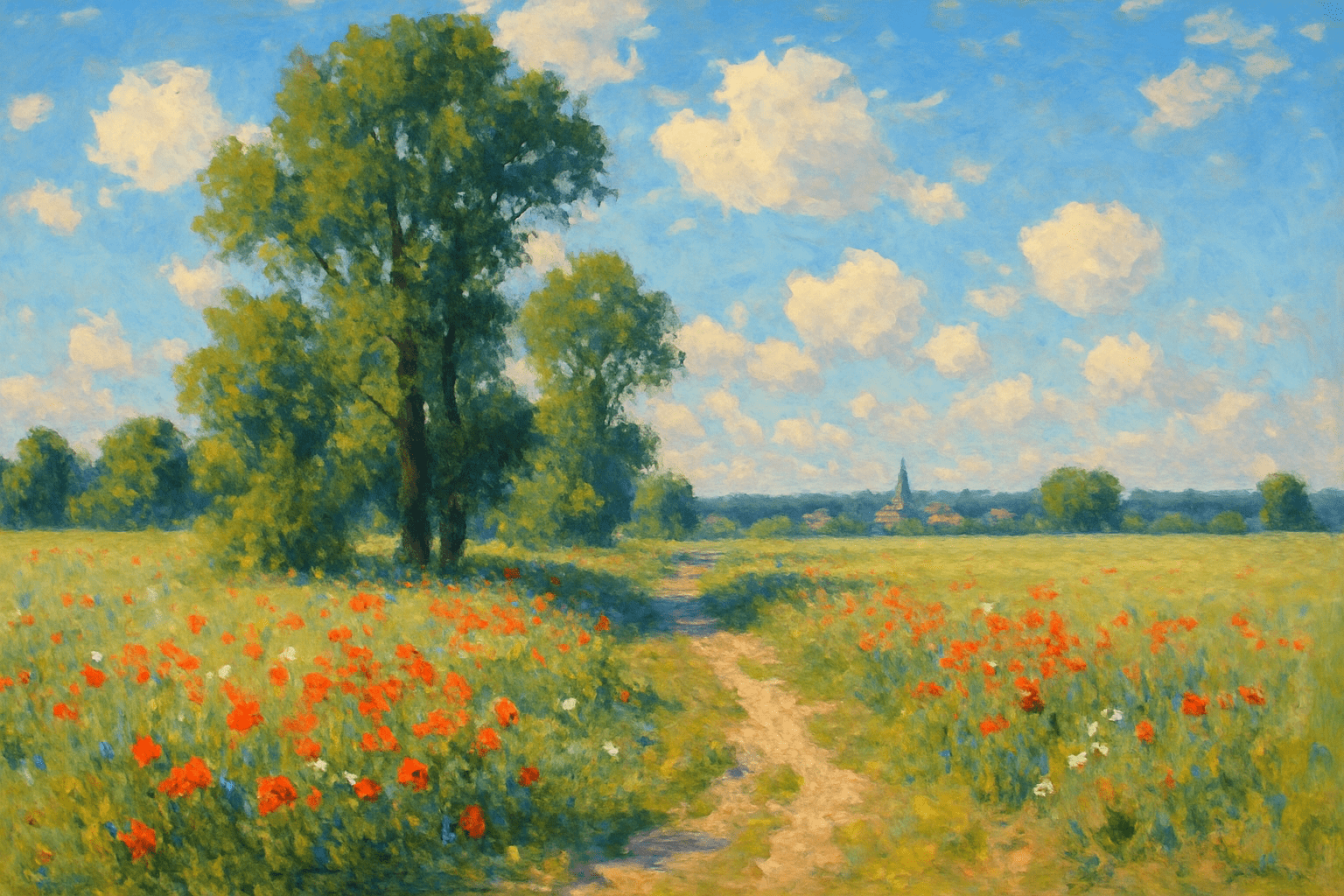
Plein Air
Plein air is a style of painting that is done outdoors. The word “plein” means “full” in French, and “air” means “air.” This style of painting was popularized in the late 1800s by French impressionist painters. The main characteristic of plein air paintings is that they are done in natural light. This means that the colors in the painting will be affected by the time of day and the weather.
AOI thinking about Plein Air [+_~]-/
Overview and Quickfacts
Plein Air is a style of painting that is done outdoors. The word “Plein” means “full” in French, and “Air” refers to the open air. This type of painting was popularized in the late 1800s by French Impressionist painters. The main goal of Plein Air painting is to capture the natural light and atmosphere of the outdoors. This can be done by painting quickly and using loose brushstrokes.
Can understand it also, as:
Outdoor, alfresco, in the open air
Categorize it as:
Impressionism, Modernism
.: Dreaming :.
holds a HAIKU for the art style
:. Thought is power .:
Detailed Description
Plein air is a French expression which means “open air”. It is used to describe the act of painting outdoors. The plein air movement began in the late 1800s, when a group of French painters decided to leave their studios and paint en plein air, or in the open air. Plein air painting allows the artist to be in direct contact with nature, and to paint the scene exactly as they see it. This type of painting requires a different set of skills than studio painting, as the artist must be able to work quickly and efficiently in order to capture the fleeting light and shadows of the outdoors. Plein air painting became popular in the United States in the early 1900s, when a number of American painters traveled to France to study the new style. Among these painters were some of the most famous names in American art, including Mary Cassatt, John Singer Sargent, and Winslow Homer. Today, plein air painting is enjoyed by artists all over the world. It is a popular way to paint on vacation, as it allows the artist to truly immerse themselves in their surroundings. Many plein air painters also participate in “paint-outs”, where a group of artists will gather together in a designated location to paint for a day or more. If you’re interested in trying your hand at plein air painting, all you need is a few supplies and a sense of adventure!
.. beep, beep, beep ..
<START OF TRANSMISSION>
1.Plein air is a French term meaning "open air." 2. It is used to describe the act of painting outdoors. 3. The practice became popular in the mid-19th century. 4. Artists would often go on painting excursions to capture the beauty of the natural world. 5. The term can also refer to the artworks themselves. 6. Plein air paintings are often characterized by their bright colors and loose brushwork. 7. The style was further popularized by the Impressionists. 8. Many famous artists have painted plein air, including Claude Monet, Pierre-Auguste Renoir, and Vincent van Gogh. 9. Painting plein air can be challenging due to the changing light and weather conditions. 10. Artists often have to work quickly to capture the scene before it changes. 11. Plein air paintings can be done in a variety of media, including oil paint, watercolor, and pastel. 12. The size of the painting is often dictated by the size of the support, which can range from a small panel to a large canvas. 13. Portable easels and folding chairs are often used when painting plein air. 14. Artists may also bring along a portable palette, brushes, and other supplies. 15. Painting plein air can be a solitary activity or it can be done in groups. 16. There are plein air painting competitions and festivals held around the world. 17. The practice of painting plein air has been credited with helping artists to develop a more intuitive approach to painting. 18. It can also be a relaxing and enjoyable activity. 19. Painting plein air is a great way to connect with nature and the world around you. 20. It is an activity that can be enjoyed by people of all ages and skill levels.
<EOF>
.. robbel bob
Visual Examples from our image gallery
Coming soon, we are so slow .. might never come
Artists, Paintings, and more
(be aware, can be highly speculative)
Artists (be aware, speculation possible):
1. William Merritt Chase (1849-1916) 2. J. Alden Weir (1852-1919) 3. John Singer Sargent (1856-1925) 4. Claude Monet (1840-1926) 5. Pierre-Auguste Renoir (1841-1919) 6. Paul CÃÂézanne (1839-1906) 7. Vincent van Gogh (1853-1890) 8. Georges Seurat (1859-1891) 9. Paul Gauguin (1848-1903) 10. Henri Matisse (1869-1954) 11. Edward Hopper (1882-1967) 12. Andrew Wyeth (1917-2009) 13. Georgia O’Keeffe (1887-1986) 14. John Marin (1870-1953) 15. Charles Burchfield (1893-1967) 16. Richard Diebenkorn (1922-1993) 17. Maynard Dixon (1875-1946) 18. Thomas Hart Benton (1889-1975) 19. Winslow Homer (1836-1910) 20. James McNeill Whistler (1834-1903) 21. Frederic Remington (1861-1909) 22. Charles Russell (1864-1926) 23. Mary Cassatt (1844-1926) 24. John Sloan (1871-1951) 25. Arthur Dove (1880-1946) 26. Charles Demuth (1883-1935) 27. Stuart Davis (1892-1964) 28. Reginald Marsh (1898-1954) 29. Rockwell Kent (1882-1971) 30. Grant Wood (1891-1942)
Artworks (be aware, speculation possible)
1. The Hay Wagon, by American painter Andrew Wyeth (1937) 2. The Haystacks, by French painter Claude Monet (1890) 3. The Red Poppies, by French painter Vincent van Gogh (1890) 4. The Rocks, by French painter Paul CÃÂézanne (1898-1900) 5. The Wheat Field, by Dutch painter Vincent van Gogh (1890) 6. The Beach at Trouville, by French painter EugÃÂène Boudin (1870) 7. The Boulevard des Capucines, by French painter Claude Monet (1873) 8. The CafÃÂé Terrace at Night, by Dutch painter Vincent van Gogh (1888) 9. The ChÃÂâteau de Medan, by French painter Paul CÃÂézanne (1879-1882) 10. The Coast near Antibes, by French painter Claude Monet (1888) 11. The Creuse Valley, by French painter Paul CÃÂézanne (1885-1887) 12. The Dunes at Trouville, by French painter EugÃÂène Boudin (1864) 13. The Farmhouse in Provence, by French painter Paul CÃÂézanne (1885-1887) 14. The Garden at Giverny, by French painter Claude Monet (1900) 15. The Gare Saint-Lazare, by French painter Claude Monet (1877) 16. The Grand Canal, by French painter Claude Monet (1908) 17. The Haystacks (Snow Effect), by French painter Claude Monet (1891) 18. The House of Parliament, by French painter Claude Monet (1904) 19. The Moulin de la Galette, by French painter Pierre-Auguste Renoir (1876) 20. The Moulin Rouge, by French painter Henri de Toulouse-Lautrec (1892) 21. The Notre Dame Cathedral, by French painter Claude Monet (1892-1893) 22. The Path through the Ile Saint-Martin, by French painter Claude Monet (1867) 23. The Pont du Gard, by French painter Paul CÃÂézanne (1891-1892) 24. The Port of La Havre, by French painter Claude Monet (1872) 25. The Quai du Louvre, by French painter Claude Monet (1867) 26. The Rue Montorgueil, by French painter Claude Monet (1878) 27. The Rue Saint-Denis, by French painter Claude Monet (1878) 28. The Seine at Argenteuil, by French painter Claude Monet (1874) 29. The Seine at Chatou, by French painter Pierre-Auguste Renoir (1879) 30. The Seine at Giverny, by French painter Claude Monet (1897)
Epoch
The term Plein Air is used to describe the act of painting outdoors. The term was first used in the late 19th century and is still used today.
AI ART RESSOURCES (AKA, well Tools)
Helping tools -> predefined search links on other pages:











